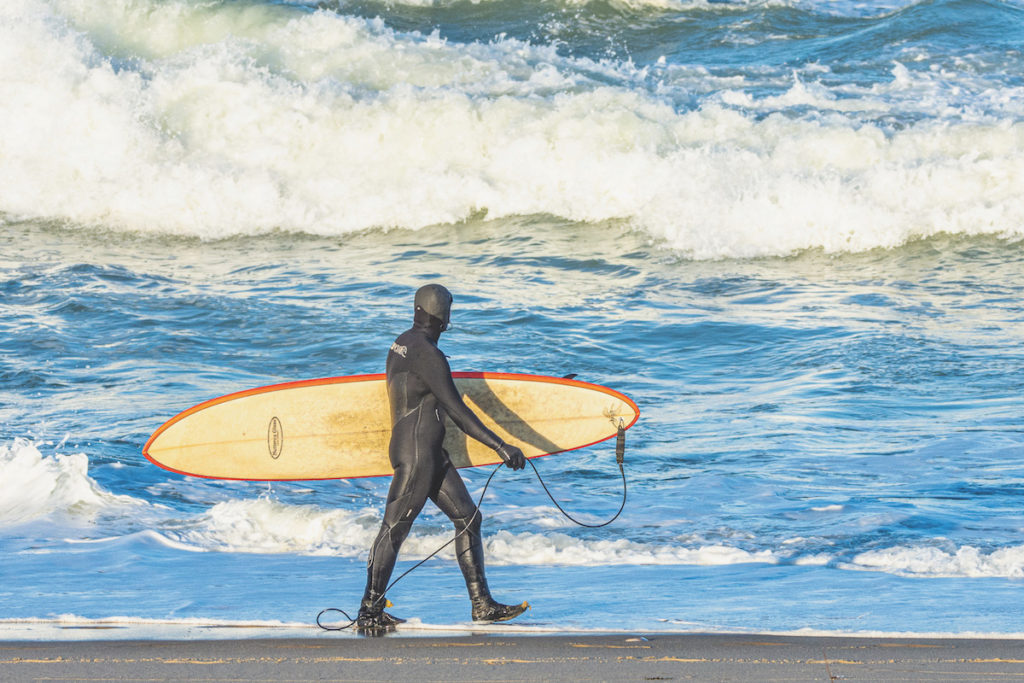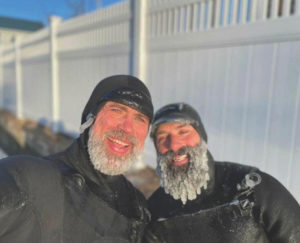
Being a surfer on Cape Cod in the winter invites a lot of questions. Willingly jumping into the ocean when the temperature dips below freezing and the waves are big is not a particularly rational thing to do. People standing at the top of the dune or walking the beach are curious about what they’re seeing. People with scarves wrapped snugly around their necks, dressed for the wind and cold. Sane people.

When one of the surfers comes walking up the dune trail, red faced and soaking wet, answers are needed.
“Are you crazy?”
Maybe.
“Aren’t you cold?”
Yes … and no. A wetsuit is what makes surfing in extreme conditions possible. It works by absorbing water and holding it close to the body where it is warmed. Water has the highest specific heat capacity (the amount of heat it must gain or lose to change its temperature) of any liquid. So, while it takes a good bit of energy to warm it up, it holds that heat very effectively.
In the water, surfers are keenly aware of the cold. The frigid water makes us ache. The wind is so sharp and hard it feels material. But most of the time, wrapped in five to six millimeters of neoprene, surfers feel warm. It’s an internal, radiant heat — one they are aware the environment is rapidly drawing from them.
After an hour or two, the cold starts to win. It starts with a pinhole in a glove, an old suit with leaky seams, a wetsuit flushed by ocean water from a wipeout. The wind wears you down, the cold water gets in, the body tires.
Surfers tend to stay in the water until this failing point, and longer if the conditions are good. By the time you are walking back to your car, you may be profoundly cold in a way that feels as if you will never ever be warm again.
“How cold is the water?”
The average, January through March, ranges from 35° to 45° F. Being held underwater by a wave, or “duck-diving” a few waves, will make a surfer’s face ache to the bone and can invoke momentary but intense nausea. Water is its densest at 39°, so on top of being very cold, it feels heavy.
“Are the waves good?”
More weather means more waves. And as anyone who stays on the Cape through the winter knows, our weather is moody. Every big windstorm or snowstorm has the potential to create waves for us. When you pull up to the ocean and see the waves are clean, organized, their smooth faces reflecting the sun — this is what surfers look for.
The best days are those with strong west winds that groom the faces of the waves, keeping them upright and hollow. Summer has a reputation as the surf season. But while it is more friendly and accessible, the summer ocean is sleepy and calm. The winter ocean is alive, furious, and full of energy.
“Are there sharks?”
Yes. There are still sharks here in winter. Most of them migrate south to their Florida beach homes, but some of the big surly locals stay around. They tend to swim in deeper waters, hunting farther offshore. Around November, most surfers feel more at ease going into the ocean. The looming shadow in the water takes up a little less mental space as the weather cools down.
“Why do you do it?”
Most every surfer will tell you they do it because it makes them feel alive. A lot of things people do to feel alive don’t make sense. Climbing an icy mountain or trekking across a desert isn’t a comfortable thing, but people do it. Discomfort and growth tend to walk together. Pushing yourself for the sake of overcoming a challenge seems to be a human trait.
The simple answer is: winter surfing provides a sense of joy that’s needed during these cold, dark months. It’s just fun. It makes us smile.
